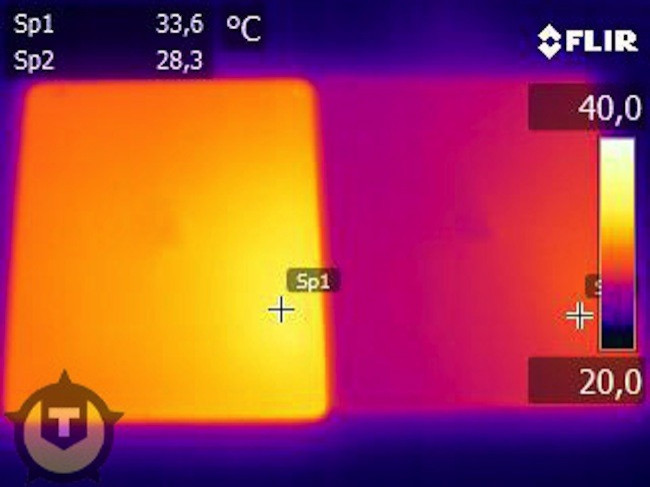New iPad '3' Features Review: Is Apple's Hotter Battery Cause For Concern?

The new iPad has been breaking sales records left and right since releasing on March 16, with people lining up in droves to put their hands on the tablet's gorgeous Retina Display, test the high-speeds of 4G LTE, and take pictures with the improved 5-megapixel iSight camera. To power all of these new features and maintain a solid 10 hours of battery life, Apple had to upgrade the iPad 2's rechargeable lithium-ion battery and make it substantially bigger -- about 70 percent. But at what cost?
Dutch website Tweakers.net ran two GL Benchmarks on a new iPad and an iPad 2 for five minutes each, testing the quality and performance of the devices, and then looked at both tablets with an infrared camera. The company discovered that the new iPad reached 33.6ºC (92.5 Fahrenheit), with the hottest region nearby the device's motherboard towards the bottom of the device, while the second-generation model only reached 28.3ºC (82.9 Fahrenheit). That means on average, the new iPad gets 10 degrees hotter than its predecessor.
Now, users worry if the new iPad has the same risks as laptops, which some believe may cause testicular and reproductive dysfunction when they get too hot. While another more recent report adds that sperm is actually nuked by the electromagnetic radiation created by Wi-Fi, many new iPad users are concerned about the heat. If hot laptops can cause problems, why not a hot tablet?
Apple tells users not to worry:
The new iPad delivers a stunning Retina display, A5X chip, support for 4G LTE plus 10 hours of battery life, all while operating well within our thermal specifications, said Trudy Miller, a spokeswoman for Apple. If customers have any concerns they should contact AppleCare.
Unlike past Apple tablets, the new iPad needs to power many more robust features, including the brilliant 2048 x 1536 Retina Display that boasts 3.1 million total pixels, which is about 1 million more than an HDTV, and 44 percent greater saturation than the iPad 2. A new A5X chip with quad-core graphics helps make the videos and games really come alive, but even that chip needs an all-powerful battery to work.
The new iPad is also the first Apple iOS device to feature bands for the high-speed 4G LTE network, but while some devices don't carry the bands, every new iPad is also 3G world ready, meaning the user can roam around the world and pick up 3G with no problems. Furthermore, the new iPad can act as a personal hotspot, which can host up to five devices.
Apple originally hoped to include LTE in the iPhone 4S, but the current implementations of LTE in phones caused very short battery life, which was a major complaint by users. Apple CEO Tim Cook, in a company earnings conference call in April 2011, said first-generation LTE chipsets force a lot of design compromises.
The iPhone 4 PCB [printed circuit board] is already incredibly small, not leaving any room for an extra chip to enable LTE without shrinking the size of the battery, said Anand Shimpi, a chip expert and CEO of Anandtech.
Fortunately, Qualcomm recently unveiled the fifth iteration of its new chip, which supports TD-SCDMA, TD-LTE, HSPA+, EV-DO, embedded GPS, and LTE on TDD and FDD networks worldwide. The chip works with Android and Windows 8 devices, but by targeting so many different carriers, there's a high degree of likelihood that this will be the same chip inside the iPhone 5.
Apple also upgraded its front and rear cameras for better photos and Facetime. The rear camera, now labeled an iSight camera, features 5-megapixels and includes face detection, white balanace, and an infrared filter with advanced optics. And, of course, Apple outfitted the new iPad with auto-focus, video stabilization and full 1080p HD video recording.
And finally, while Apple didn't add Siri, the company did add one of the iPhone 4S's most popular features from Siri: voice dictation. The iPad keyboard was fitted with a new microphone button, which records whatever you say out loud and dictates your words into text in seconds.
That is a LOT of features to power for one battery, which already takes up most of the device's real estate.
So, should you worry? First of all, the chances of an iPad spontaneously combusting like an iPhone 4 are extremely low. The battery is big enough to handle the tablet's processing duties, but it gets hot. The new iPad's battery reaches 42.5 watt hours capacity, which has 70 percent more capacity than the iPad 2's 25 watt hour battery. The new iPad won't nuke your reproductive organs, but if it gets too hot for you to touch, it's probably best to turn the device off, let it rest for awhile, and if the problems arise again, contact Apple support.
As is always the case, anything could go wrong. These new iPads, while gorgeous and incredible, are not perfect, and you could be the first iPad owner to have one blow up in your face. However, if you see the warning signs, use some common sense. Let the iPad rest for a bit, it can only handle so much Netflix and YouTube. Then go back and play.
© Copyright IBTimes 2024. All rights reserved.












